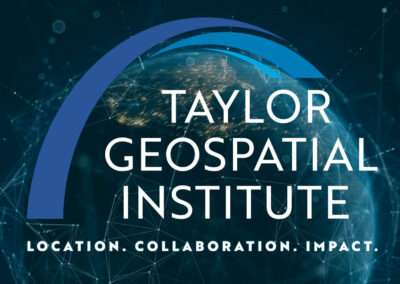By Bob Grant
The arctic tundra is a surprisingly dynamic ecosystem that at first glance appears to be a windswept, frigid wasteland. But further investigation reveals that it hosts hundreds of plant species—mostly shrubs, mosses, and grasses— that jockey for space with lichens and other low-lying lifeforms in these mostly treeless expanses. Beneath the surface lies permanently frozen soil, called permafrost, storing huge amounts of carbon that may escape into the atmosphere as methane and carbon dioxide.
As permafrost thaws, the greenhouse gasses it harbors are released into the atmosphere, causing further warming. Combined with a warming climate, this can increase the frequency of wildfires, which typically race across these landscapes on natural cycles. These changes in the arctic’s climate are an area of keen interest to researchers like Taylor Geospatial Institute Associates Mark J. Lara, Ph.D., and Roger Michaelides, Ph.D.
Lara is an assistant professor of plant biology and spatial ecologist at the University of Illinois Urbana-Champaign. Together with Michaelides, of Washington University in St. Louis, they are using cutting-edge geospatial research to track dynamic interplay between permafrost, plant communities, and wildfire in Alaskan Arctic ecosystems. Specifically, the researchers employ Interferometric Synthetic Aperture Radar (InSAR) and aircraft-mounted hyperspectral remote sensing to study how tundra plant communities change and permafrost expands and subsides in the Yukon-Kuskokwim (Y‑K) River Delta in response to wildfires that have swept across the area in the past.
The duo’s study site is an ideal spot to track both the geophysical and biological responses to frequent wildfires and to ground-truth “spectral diversity” a remote proxy for plant community diversity that can be gathered from hyperspectral sensors.
“This is a really awesome site, given that there is a nice chronosequence of wildfire that has occurred there over the last 40 to 50 years,” Lara said. “We can target all our analysis, ranging from the hyperspectral analysis of spectral diversity to the InSAR derived subsidence analysis, within historical burn scars to look at the relative patterns of vegetation succession, in line with this spectral diversity approach.”
Lara and Michaelides were brought together under the umbrella of a TGI seed grant meant to fuel their study and their collaboration. “I think it’s a great match,” said Lara. “Given that our interests are both pretty closely aligned—he works more with RADAR-based remote sensing of Arctic and high latitude systems, and I work more with optical-based remote sensing in arctic systems as well—that’s one of the reasons why this research is moving so fast. This collaboration was just one way that we credit TGI for contributing to our success.”
The researchers’ progress, aided by geospatial information and tools, has been rapid indeed. Lara notes that the geospatial study of the Y‑K Delta has already yielded key insights, and that the team is preparing a proposal to secure additional funding from the National Science Foundation to continue and expand on the research. The main takeaways from their first study of the area include:
- Measuring spectral diversity is a good proxy for plant diversity at the site. “That’s something that I think we’ve nailed nicely,” Lara noted. “Spectral diversity was able to approximate where different plant communities exist across space.”
- The researchers uncovered a correlation between the time since an area of the Y‑K Delta burnt and the spectral diversity in that area. “This pattern correlates with patterns of plant species succession, confirmed from our ground-based measurements,” Lara said. “The interaction between diversity and disturbance metrics will be a great contribution to environmental remote sensing.”
- Spectral diversity was also shown to correlate with surface subsidence, which tends to happen after fire rips through tundra landscapes as permafrost melts. “The chronosequence of wildfire disturbance was linked to the magnitude of surface subsidence, and with diversity,” Lara said. “However, was subsidence driving vegetation change and vegetation change driving spectral diversity? Or was it that the changes in vegetation composition were locally altering subsidence signals, which were together altering spectral diversity? So I think there’s more experimental work that needs to be done to try to understand this relationship.”
As Lara and Michaelides progress in their research, they stand not only to harvest more geospatial data from dynamic tundra landscapes in Alaska, but to apply the methodologies they’re employing, especially using spectral diversity as a measure of plant diversity, to rapidly changing ecosystems across the globe. “Applications of spectral diversity are extremely limited in Arctic ecosystems,” said Lara. “This research will help to get both the community and Roger and I to start thinking about the utility of spectral diversity for understanding the consequences of such widespread patterns of disturbances, climate responses, and other rapid changes in high-latitude environments.”
As the arctic tundra’s climate and permafrost continue to change, Lara and Michaelides will continue to collaborate, track these changes, and better understand their impacts on the planet. With the power of geospatial data and collaborative research, these two TGI Associates continue to be a strong example of the strength of the TGI community and the consortium of 8 research and academic institutions, government organizations, and industry partners that represent it.
Interested in learning more about Synthetic Aperature Radar? Join TGI on May 14–15, 2004 for the Fundamentals of SAR Workshop, hosted by Tom Ager, former NGA SAR Program Manager. The two-day workshop will describes Synthetic Aperture Radar (SAR) imaging for geospatial students and professionals who do not have advanced degrees in electrical engineering. Sponsored by ICEYE, the event will include expansive explanations, hundreds of illustrations and images, a few simple equations, and even a bit of prose and music to review the remarkable capabilities of SAR.


